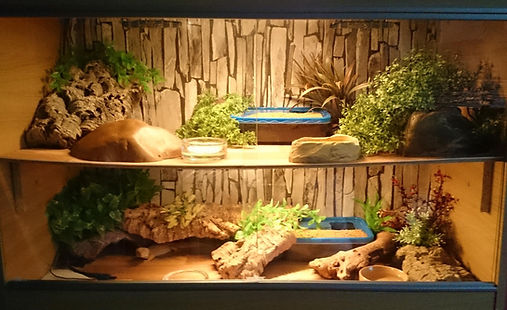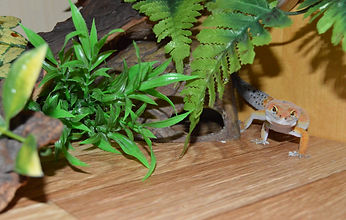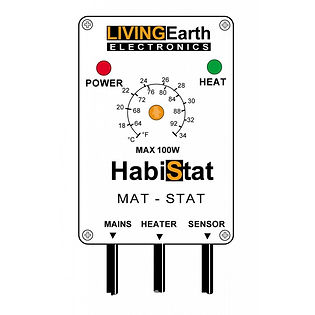
EUBLEPHARIS
MACULARIS

Husbandry
Leopard geckos are native to Pakistan, Afghanistan, India and Iran - where they are found in Harsh Arid mountain regions. Leopard Geckos get to 8-10 inches in length as an adult.
They are crepuscular ground dwelling lizards taking cover in rocky outcrops or dug holes during the day to escape the humidity. They are seen at night laying flat on the ground soaking up the heat when the humidity is not as high, this helps aid their digestion.
Leopard geckos are a very popular first time reptile for many keepers, they don’t grow to be huge and become accustomed to handling over time. They don’t have many needs if you have the correct set up and maintain cleaning and feeding schedules.
Being a gecko that has been bred in captivity for many years there is now a long list of different morphs that are all stunning.
A wooden Vivarium is better suited for these animals. Wood holds the heat better then a glass terrarium and wooden vivs come in larger sizes compared to glass ones.
A wooden viv generally is low in height but long which is a lot more suited to these geckos they are not arboreal like crested geckos that need height which is best found in a glass terrarium. Not to say a glass terrarium cannot be used as there are a few models that are long like the Exo Terra Natural Terrarium Large/Low.
For a young baby to adulthood a 2ft vivarium is an adequate space to house them within. Some people prefer to go into a larger vivarium like a 3ft vivarium allowing the adults more floor space and giving the owner mores space to add bigger hides that are more adequate compared to a small hide for a baby. Most medium hides are adequate sizes for juveniles and adults if you don’t want to buy more hides when they are getting bigger.

Maintaining the Temperature
Alongside all the necessities you also need 2 mandatory items being a
-
Heat mat
-
Thermostat
These two items are mandatory these help aid your reptile in digestion and also keeps the right temperature so they aren’t to cold or are cooked by the heat
A heat mat is a rectangular mat that is connected to a thermostat. The thermostat will have a dial that you turn to set the desired temperature being 30-32c
The standard Thermostat's are 'on + off' stats turning on to reach the desired temperature then turning off until it drops enough to then turn back on (This doesn’t drop a huge amount normally varies by 5 degrees i.e. turns on at 27 degrees heats to 32 degrees then turns off and starts the cycle again.)
To set these two items up correctly in the viv is rather easy;
-
The heat mat is plugged into the thermostat
-
Heat mat placed into the Viv on the floor
-
Substrate to go on top of the heat mat
-
Thermostat probe (sensor) goes directly on the substrate where the heat mat would be if substrate was removed
-
Turn the dial Clockwise to 28/30 (Alot of stats are not exact)
-
Plug the stat in and turn on the mains
Once this is done allow the mat to warm up and using a digital thermometer keep an eye on the temperature making sure it isn’t to cold or hot every stat needs a little adjusting (Make sure this is set up before you buy your gecko.)

Per gecko you need;
-
Solid substrate - tile, paper towel or excavator clay
-
Heat Mat
-
Thermostat or dimmer
-
Temperature gun Or reliable thermometer
-
Minimum of 3 (three) hides
-
Decor - branches and vines
-
Shallow water dish
-
Food dish
-
Calcium dish
-
Calcium powder + D3
-
Calcium powder
-
Multivitamin powder
-
Feeder insects
-
Digital scale
Your substrate can be many choices;
-
Slate
-
Kitchen roll
-
Lino (Non-adhesive ONLY (get this from a proper carpet shop not from a pound store)
-
Newspaper
-
Exo Terra Sand Mat
-
Reptile carpet
-
Zoo Med excavator clay (When set correctly)
